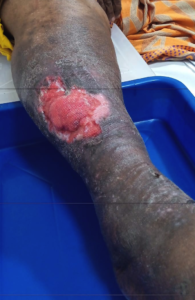A leg ulcer is simply a break in the skin of the leg, which allows air and bacteria to get into the underlying tissue. This is usually caused by an injury, often a minor one that breaks the skin.
In most people such an injury will heal up without difficulty within a week or two. However, when there is an underlying problem the skin does not heal and the area of breakdown can increase in size. This is a chronic leg ulcer.
How does venous disease cause ulcers?
The veins in your leg are tubes that carry the blood back from the foot towards your heart. The veins in your legs have one-way valves that make sure the blood flows up the leg and not back down. In some people, these valves are not very effective or can be damaged by thrombosis (clots) in the veins. If the valves are damaged, blood can flow the wrong way down the veins, which results in a very high pressure in the veins when standing up. This abnormally high pressure in the veins damages the skin and leads to the ulcers.

How will I be treated?
Treatment of a venous leg ulcer happens in two ways:
- Controlling the high pressure in the leg veins
- Treatment of the ulcer
The mainstays of treatment are
- compression bandaging
- stockings and
- elevation of the limb
- Treatment of reflux
- Treatment of deep veins
Elevation of the limb
The higher the leg, the lower the pressure in the leg veins. If the foot is elevated above the heart then the pressure in the foot drops to a normal level. Put your legs up whenever you can and as high as you are able-the arm of the sofa is good. Elevate the lower end of your bed (6 inches or so) so that when in bed your feet are a little higher than your head. You can use some old books for this.
Compression bandaging or stockings
In order to keep the pressure in the leg veins at the ankle low when you are standing up, you will be treated with compression bandaging or stockings. Several layers of bandages may be required to get the necessary pressure to control the veins. Once the ulcer is healed, compression stockings are usually necessary to prevent the ulcer from returning. These stockings need to be specially fitted and are much stronger than ordinary “support tights”. If you have difficulty putting on your stockings then you can buy a special stocking applicator.
Dressings
The nurse will use a number of different dressings under the bandages depending on the state of the ulcer itself. These dressings may well change as the ulcer progresses
Surgery
This is indicated for patient with
- Superficial venous reflux – this is treated by sealing the leaking vein by laser / RFA procedure
- Deep venous occlusion – this will require angiogram with angioplasty/stenting of the veins
How long will it take the ulcer to heal?
It has usually taken many years for the venous disease to cause the ulcers, so it is not surprising that the ulcers may take a fairly long time to heal. Although most venous ulcers will heal in 3-4 months, a small proportion will take considerably longer. Don’t despair! Even in these resistant cases, treatment is eventually successful.
How can I stop the ulcer coming back?
Once your ulcer is healed, it does not mean that your problems are over. Your skin damage remains and you must take precautions to prevent the ulcer recurring:
- Wear compression stockings at all times during the day – if you are not able to, ask your vascular surgeon for alternatives
- Elevate the legs whenever possible.
- Keep the skin in good condition by using plenty of moisturising cream to prevent dryness.
- Weight loss, fresh fruit, exercise and stopping smoking are also vital to help heal your ulcer as well as for your general health.

